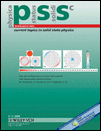Diode effect in transport through a quantum dot coupled to non-collinearly polarized ferromagnetic leads
Abstract
Electron tunneling through a spin-split discrete level of an interacting quantum dot coupled to two ferromagnetic electrodes with non-collinear magnetizations is investigated theoretically by means of the nonequilibrium Green function approach. It is shown that the spin splitting of the dot level due to an external magnetic field leads to qualitatively new effects. In particular, numerical results show that the negative differential conductance and diode effect may occur in symmetrical junctions with non-collinear magnetizations and for large enough magnetic polarization of the leads. It is also found that in asymmetrical junctions with one electrode being half-metallic, the spin splitting gives rise to an enhancement of the diode-like features in transport characteristics. (© 2006 WILEY-VCH Verlag GmbH & Co. KGaA, Weinheim)




